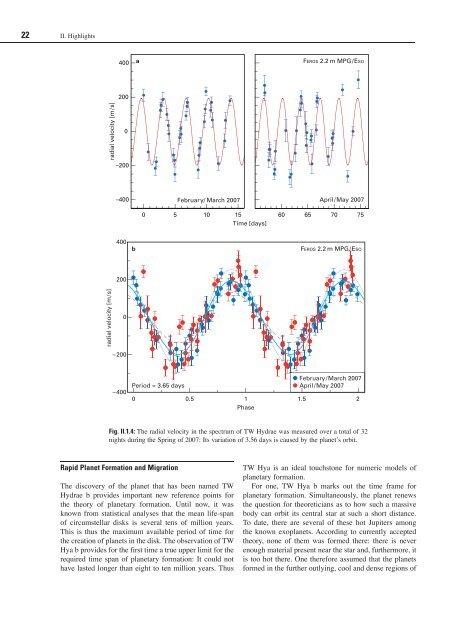Max Planck Institute for Astronomy - Annual Report 2007
Max Planck Institute for Astronomy - Annual Report 2007
Max Planck Institute for Astronomy - Annual Report 2007
You also want an ePaper? Increase the reach of your titles
YUMPU automatically turns print PDFs into web optimized ePapers that Google loves.
22 II. Highlights<br />
radial velocity [m/s]<br />
radial velocity [m/s]<br />
400 a<br />
200<br />
–200<br />
–400<br />
Fig. II.1.4: The radial velocity in the spectrum of TW Hydrae was measured over a total of 32<br />
nights during the Spring of <strong>2007</strong>: Its variation of 3.56 days is caused by the planet’s orbit.<br />
Rapid Planet Formation and Migration<br />
0<br />
400<br />
200<br />
0<br />
–200<br />
–400<br />
b<br />
0<br />
February/ March <strong>2007</strong><br />
0 5 10 15<br />
Time [days]<br />
60 65 70 75<br />
Period = 3.65 days<br />
0.5 1<br />
Phase<br />
The discovery of the planet that has been named TW<br />
Hydrae b provides important new reference points <strong>for</strong><br />
the theory of planetary <strong>for</strong>mation. Until now, it was<br />
known from statistical analyses that the mean life-span<br />
of circumstellar disks is several tens of million years.<br />
This is thus the maximum available period of time <strong>for</strong><br />
the creation of planets in the disk. The observation of TW<br />
Hya b provides <strong>for</strong> the first time a true upper limit <strong>for</strong> the<br />
required time span of planetary <strong>for</strong>mation: It could not<br />
have lasted longer than eight to ten million years. Thus<br />
FEROS 2.2 m MPG/ESO<br />
April/May <strong>2007</strong><br />
FEROS 2.2 m MPG/ESO<br />
February/March <strong>2007</strong><br />
April/May <strong>2007</strong><br />
1.5 2<br />
TW Hya is an ideal touchstone <strong>for</strong> numeric models of<br />
planetary <strong>for</strong>mation.<br />
For one, TW Hya b marks out the time frame <strong>for</strong><br />
planetary <strong>for</strong>mation. Simultaneously, the planet renews<br />
the question <strong>for</strong> theoreticians as to how such a massive<br />
body can orbit its central star at such a short distance.<br />
To date, there are several of these hot Jupiters among<br />
the known exoplanets. According to currently accepted<br />
theory, none of them was <strong>for</strong>med there: there is never<br />
enough material present near the star and, furthermore, it<br />
is too hot there. One there<strong>for</strong>e assumed that the planets<br />
<strong>for</strong>med in the further outlying, cool and dense regions of

















